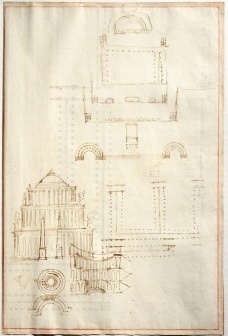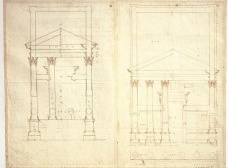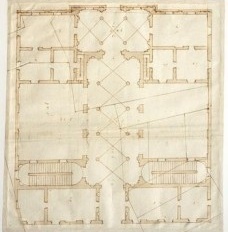
newspaper
agenda cultural
The CCA exhibition reveals the working process of this influential late renaissance architect
Montréal, 23 February 2011 — The Canadian Centre for Architecture (CCA) presents Palladio at Work, curated by Guido Beltramini with the collaboration of Charles Hind. On view in the museum’s Octagonal Gallery from 3 March until 22 May 2011, the focused examination of 15 drawings by the late Italian Renaissance master Andrea Palladio (1508-1580), from the collections of the Royal Institute of British Architects, also includes his influential book I Quattro Libri dell’Architettura (1570) and other material from the CCA Collection. Guido Beltramini addresses contemporary questions and gives new insight on Palladio’s working method through extensive annotations in the form of diverse reference materials, images, and texts.For Palladio, who was introduced to draftsmanship as a stonecutter at the age of thirteen, drawing played a central role: it was his tool for acquiring knowledge, for measuring and for constructing, as well as his way to earn a living. Palladio at Work invites an investigation of his drawings not simply for their aesthetic beauty, but as a way to better understand this influential architect’s working process. By analyzing how Palladio constructed different types of drawings for different purposes – such as personal inspiration, persuading clients, or publishing – the exhibition brings visitors closer to his visionary thinking. The fact that just three of the sixteen projects on view in the exhibition were built only emphasizes the important role paper plays in preserving and understanding Palladio’s work and legacy.
CCA Executive Director and Chief Curator Mirko Zardini states, “At the CCA we are always concerned with the working process, and our Collection is focused on preserving archives that encourage scholarship and better understanding of architects’ thinking and methods. In line with this mandate, this exhibition offers our visitors an exciting new context for Palladio’s historical material, with a character not unlike that of a university seminar.” The exhibition distinguishes itself from others on the architect by investigating a concentrated body of his work from a contemporary perspective.
“The drawings selected for this exhibition create an itinerary that enables us to see Palladio at work, as if we were looking over his shoulder. We will try to witness how his ideas arise when he sets himself before a blank paper, thereby understanding his sources of inspiration, and how he shapes them for his own needs,” said Guido Beltramini.
ABOUT THE EXHIBITION
Palladio at Work has been produced in collaboration with the Royal Institute of British Architects and Centro internazionale di studi di architettura Andrea Palladio. Palladio drawings in the exhibition are from the unique collection held by the Royal Institute of British Architects. The exhibition is curated by Guido Beltramini with the collaboration of Charles Hind. Born in Padua, Italy in 1508, Andrea Palladio lived and worked in the city of Vicenza from the age of sixteen. He was a trained stonemason and began designing villas for the wealthy patrons of Vicenza in the 1540s. The influence of ancient architecture and the writing of Vitruvius can be seen early on in Palladio’s use of huge vaults and loggia façades of a scale uncommon in private homes of the period. Between 1542 and 1550 Palladio was also involved with the design of three major city palaces in Vicenza. Alongside the villas and palazzi in and surrounding Vicenza, Palladio built churches in Venice. His recognition as one of the most influential figures in Western architecture was bolstered by his architectural treatise I Quattro Libri dell’Architettura, featuring many of his own designs.
Palladio’s drawings encompass a range of techniques and styles that trace the key stages in his work: making detailed records of ancient ruins, creating personal drafts to capture his raw ideas, refining and perfecting those ideas for his own reference, communicating with clients or patrons, and finally translating his ideas for a larger audience through illustrated books. Five sections in the exhibition explore this working process and take the viewer on a journey alongside the architect.
In the first section, Studying Ancient Ruins, three drawings show Palladio’s study of the ancient ruins of Rome and reflect the role antiquity served as inspiration for his designs. The second section, First Ideas on Paper, includes two of the few surviving papers on which Palladio drew loosely without any guidelines or axes of symmetry. They are particularly intriguing and valuable for revealing how Palladio quickly captured initial ideas as they came to mind. In the third section, Study Drawings, three refined studies made with the aid of drawing instruments reveal how Palladio developed his ideas, checked measurements and proportions, and explored alternatives contains. An additional drawing by Vincenzo Scamozzi (1552-1616) from the CCA Collection gives insight on Palladio’s collaboration with the younger architect who for the first time drew the shading on Palladio’s renderings to show the effect of sunlight on façades. In the fourth section, Presentation Drawings, the perfectly executed visualizations of his proposals are now clearly tools for communicating his ideas to others and include shading and ornamental figures drawn by other artists. The drawings in this group bracket his career with the project for Villa Pisani from the early 1540s, when he was still a young man, and the project for the church of the Redentore done towards the end of his life. The final section, Drawings for Publication, includes drawings alongside examples of his books from the CCA Collection. Palladio created new drawing methods to convey the key information about a building as economically as possible in publication, and the books’ effective design and juxtaposition of text with illustrations became a model for all subsequent architectural books.
THE CURATORS
Guido Beltramini has been the executive director of the Palladio Study Center in Vicenza (Centro internazionale di studi di architettura Andrea Palladio) for 20 years and is the author of numerous books and essays devoted to Palladio. An expert in the architecture of Renaissance Italy, he was also the co-curator of the touring exhibition Palladio and His Legacy: A Transatlantic Journey (with venues at The Morgan Library & Museum, New York; the National Building Museum, Washington, DC; and the Carnegie Museum of Art, Pittsburgh) and the Palladio exhibition celebrating the quincentenary of his birth that have appeared in Vicenza, London and Madrid. Beltramini has authored and co-authored several books, including Andrea Palladio and the Architecture of Battle: With the unpublished edition of Polybius’ Histories (2010), the first organic study on Palladio’s interests in the arrangements of the Roman army, and Palladio, with Howard Burns, professor of architectural history at the Scuola Normale Superiore in Pisa, Italy. The book, published in 2008, examines Palladio’s life, achievements, and architectural designs and celebrated the 500th anniversary of his birth. These publications are available at the CCA Bookstore: www.cca.qc.ca/bookstore or 514 939-7028.
Beltramini’s collaborator for this exhibition, Charles Hind is Associate Director of the RIBA British Architectural Library and H.J. Heinz Curator of Drawings. Hind is an expert in art and architecture of 18th-19th century England including Anglo- Palladianism. He is the author of essays on Inigo Jones and Lord Burlington in the catalogue of the recent major travelling exhibition on Palladio, celebrating his quincentenary. He edited, with Irena Murray, the catalogue Palladio and His Legacy: A Transatlantic Journey (2010), an exhibition that he co-curated with Guido Beltramini.
RELATED PROGRAMS
The CCA hosts a Gallery Talk in the Octagonal Gallery on Thursday, 3 March at 7 pm with curator Guido Beltramini. Free admission

Andrea Palladio. Idealized reconstruction of the overall plan of the Temple of Fortune, Palestrina. c. 1570. London, RIBA British Architectural Library. VIII/11v

Andrea Palladio. Plan and elevation of a tetrastyle prostyle temple in the Corinthian order and the Temple of Minerva, Assisi. 1560s. London, RIBA British Architectural Library, XI/14r

Andrea Palladio. Study of a plan for a palace with two courtyards. c. 1570. London, RIBA British Architectural Library. XVI/10r

